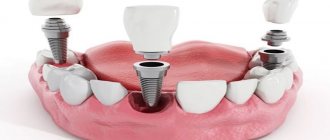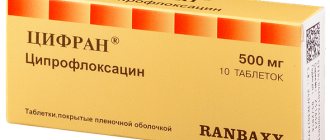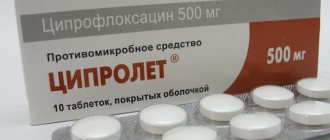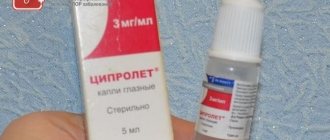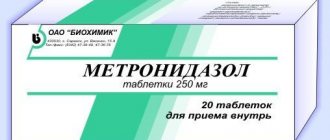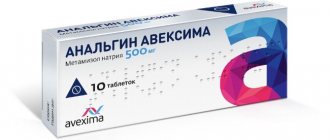Characteristics of Ciprofloxacin
The drug has an antibacterial effect and has the ability to cause the death of pathogenic microorganisms. Produced by a number of Russian manufacturers. Israeli-made tablets are also available on the pharmaceutical market.
Ciprofloxacin has an antibacterial effect and has the ability to cause the death of pathogenic microorganisms.
The following forms of the drug are available:
- tablets (250 and 500 mg);
- solution for infusion (200 mg per 100 ml);
- drops for eyes and ears (3 mg);
- ointment (0.3 g per 100 g).
The active ingredient is ciprofloxacin. It has an inhibitory effect on bacterial DNA gyrase, disrupting the DNA synchronization mechanism and the formation of cellular proteins in microorganisms.
The activity of the drug is manifested against bacteria that are in the stage of rest and reproduction.
Differences
Tsiprolet and Tsipromed have the following differences:
| Tsiprolet | Tsipromed | |
| Release form | The drug is commercially available in eye drops, solution for infusion, and tablets for oral administration. | The drug is available in the form of ear and eye drops. |
| Use in pediatrics | Eye drops can be used for patients older than 12 months. Tablets and infusions can be prescribed to children over 5 years of age to treat and prevent pulmonary anthrax. They can also be prescribed to patients in this age group suffering from cystic fibrosis to prevent complications caused by Pseudomonas aeruginosa. | Eye drops are allowed for children over 1 year of age, ear drops are allowed only for patients over 15 years of age. |
| Adverse reactions | Tablets and infusions can cause dizziness, cephalgia, fatigue, insomnia, trembling of certain parts of the body, anxiety, nightmares, peripheral paraalgesia, excessive sweating, intracranial hypertension, depression, hallucinations, migraines, fainting, thrombosis of the cerebral arteries, agitation , disorientation, convulsions, paresthesia, dysesthesia, hypoesthesia, gait disorder, hyperesthesia, peripheral neuropathy and polyneuropathy, perversion of taste and smell, double vision, hearing loss, tinnitus, increased heart rate, prolongation of the QT interval, vasodilatation, hypotension, ventricular arrhythmias, nausea, vomiting, indigestion, abdominal pain, bloating, lack of appetite, inflammation of the pancreas, hepatitis, hepatonecrosis, inhibition of bone marrow hematopoiesis, serum sickness, a decrease in the amount of all formed blood elements, the appearance of blood and protein in the urine, crystalluria, dysuria , polyuria, urinary retention, renal failure, glomerulonephritis, bleeding from the urethra, interstitial nephritis, respiratory failure, joint and muscle pain, arthritis, tendovaginitis, tendon rupture, impotence, muscle hypertonicity, muscle weakness, exacerbation of myasthenia gravis, increased activity of liver enzymes, levels creatinine, bilirubin and sugar, hot flashes, superinfection. Infusions may cause swelling at the injection site. | Ear drops can cause the eardrum to become red and painful. |
We suggest you read: What to rinse your mouth with inflamed cheeks
Characteristics of Tsiprolet
The medicine is produced by the Indian manufacturer Dr. Reddy's Laboratories Ltd. Implemented in the following forms:
- tablets of 250 and 500 mg;
- solution for intravenous administration (2 mg per 1 ml);
- eye drops (3 mg).
The main substance in the composition is ciprofloxacin. The pharmacological effect completely coincides with the mechanism of action of the previous drug.
Comparison of Ciprofloxacin and Ciprolet
Both drugs are fluoroquinolone antibiotics.
Similarities
When comparing drugs, the main properties do not differ:
- They contain the same active ingredient.
- The drugs have the same dosage form and dosage options. The treatment regimen and course duration depend on the disease and are calculated individually by the attending physician, taking into account the patient’s clinical picture and medical history.
- Mechanism of action. In bacteria, the enzyme gyrase (belongs to the group of topoisomerases) is responsible for the construction of supercoils in the circular DNA molecule. The active ingredient blocks the activity of the enzyme. This leads to stopping the growth of bacteria and their death, stopping the infectious process.
- In both cases, the active component is effective against a number of enterobacteria, cellular pathogens, and affects gram-negative and gram-positive environments. The bacteria Ureaplasma urealyticum, Clostridium difficile, and Nocardia asteroides are resistant to the substance. Treponema pallidum and mushrooms are not sensitive to drugs.
- Indications for use. Both drugs are prescribed in the treatment of infectious diseases in uncomplicated forms and cases of secondary infection joining a bacterial infection. Indications include infections of the respiratory tract and ENT organs. Medicines are widely used for lesions of the eyeball, diseases of the kidneys and genitourinary system, and pelvic organs. The list of prescriptions includes infections of the digestive system, biliary system, skin, bone and soft tissue. The drugs are used for sepsis and peritonitis.
- Medicines have the same list of contraindications for use: pregnancy and breastfeeding, age less than 18 years, individual intolerance. Careful use requires a history of impaired blood circulation and cerebral atherosclerosis, mental disorders, and epilepsy. Treatment requires special monitoring in elderly patients, as well as in the presence of diabetes mellitus and severe liver and kidney failure.
- Possible side effects from the cardiovascular and nervous systems, gastrointestinal tract and liver, musculoskeletal system, and hematopoietic system do not differ. External manifestations of an allergic nature are possible.
- During the treatment period, the speed of psychomotor reactions and attentiveness may decrease.
- Taking medications should be accompanied by sufficient fluid intake to prevent crystalluria.
The pharmacokinetics of both drugs is characterized by rapid absorption in the walls of the gastrointestinal tract.
The similarity of the drugs is also expressed in the features of drug compatibility:
- Combination with a number of anti-inflammatory drugs is not recommended due to the risk of seizures.
- The effectiveness of the active substance decreases with simultaneous use of antacids, as well as drugs containing calcium, iron and zinc salts.
- When interacting with Theophylline, the concentration of the latter substance in the blood may increase.
- Concomitant use of drugs containing cyclosporine increases serum creatinine levels.
- The active substance of the drugs enhances the effect of warfarin-based drugs.
Both drugs are prescription drugs.
What is the difference?
The drugs are structural analogues. The main difference is in the manufacturer. Ciprofloxacin is produced by several pharmaceutical companies, and the trade name Ciprolet belongs to an Indian company. Due to differences in pricing policies, the cost of medicines is different.
Tsiprolet is not available in the form of an ointment.
Which is cheaper?
The approximate cost of Tsiprolet in pharmacies is:
- tablets 250 mg (10 pcs.) - 55-60 rubles;
- tablets 500 mg (10 pcs.) - 100-120 rubles;
- solution 100 ml - 80-90 rubles;
- eye drops 5 ml - 50-60 rubles.
The average price of Ciprofloxacin tablets is 30-120 rubles, solution - 30-40 rubles. Eye drops cost 20-25 rubles.
Ciprolet and Ciprofloxacin: the difference, what to choose for effective treatment
However, the described medications are ineffective when it comes to fighting fungi or Treponema pallidum.
The drugs are not toxic, since the active substance is quickly distributed throughout the body, easily entering all types of tissues (including the brain), practically does not interact with blood proteins, and is then completely excreted in the urine.
Depending on the severity of the disease, its degree, the infection that caused the disease, as well as other factors, the doctor selects the necessary course of treatment, which will provide the necessary effect on the body. In addition, the duration of therapeutic measures using the described medications depends on the listed factors.
The greatest effectiveness of these medications is observed when taken orally on an empty stomach, due to which the concentration of the drug in the blood becomes maximum within 1-2 hours.
Storage
Tablets should be kept in a dry, dark place, out of reach of children, at a temperature of 15 - 25 ° C. The solution and drops can be stored at a temperature of 2 – 25 ° C.
Interaction with other tools
Drugs prescribed for diabetes mellitus enhance the effect of the active substance, increasing its concentration in the blood.
Anti-inflammatory drugs do not combine well with Ciprofloxacin, and their use sometimes provokes seizures.
Diuretics increase the concentration of the active substance in the blood plasma.
Ciprolet and Ciprofloxacin are not recommended to be taken together with non-steroidal anti-inflammatory drugs to avoid seizures.
The combination of the described drugs with Cyclosporine causes serious damage to the kidneys.
Antacids based on aluminum and magnesium can slow down the absorption of the active substance and reduce the effectiveness of taking the drug. In addition, they also cause harm to the stomach walls.
Indications
Taking medications is indicated in the presence of infectious and inflammatory processes, which include:
- lung abscess, pneumonia,
- gonorrhea,
- chlamydia,
- peritonitis,
- sepsis,
- cholecystitis, abdominal abscesses, gall bladder suppuration,
- salmonellosis, cholera, typhus, dysentery,
- inflammation in the oral cavity,
- infection of mucous tissues.
In ophthalmology:
- conjunctivitis, corneal ulcer,
- otitis,
- eyeball injuries, etc.
Also, taking Ciprolet and Ciprofloxacin can be of a prophylactic nature after intracavitary operations or when the immune system is weakened after a long illness.
Contraindications for use
Taking antibiotics in the vast majority of cases creates a serious burden on the body, which is why it is necessary to consult a doctor before starting treatment. The use of Ciprolet and Ciprofloxacin is not recommended for the following categories of people:
- pregnant and lactating women,
- patients with intolerance to the components contained in the drugs,
- people suffering from kidney and liver diseases,
- patients under 18 years of age,
- people with mental disorders.
When using such medications, attention should be paid to the condition of the patient’s kidneys and liver, since these organs are used to remove the active components of Ciprolet or Ciprofloxacin from the body.
Patients suffering from a lack of glucose-6-phosphate dehydrogenase (related to hereditary pathologies), as well as those who have pseudomembrane colitis, should refrain from taking it - the use of these drugs is contraindicated for them. In addition, patients who have cerebral atherosclerosis, as well as convulsions or epileptic seizures, must undergo a thorough examination in the clinic before using the drug.
The only restriction on the use of the drug, supplied in the form of eye drops, is age: it should not be used in the treatment of children under 12 years of age.
Side effects: Tsiprolet
In the manufacture of this product, special attention is paid to purifying its components from undesirable impurities and strictly observing all production conditions, so its use is tolerated quite easily, unlike most other drugs in this spectrum.
However, the risk of individual intolerance to the components cannot be excluded, which in some cases is manifested by the appearance of one or more side effects, including:
- ripples and pain in the eyes,
- hallucinations,
- increased sensitivity of the skin - especially to sunlight, which results in rashes and irritation,
- allergic reactions – skin itching, anaphylactic shock, etc.,
- neurological disorders - depression, depressed states, anxiety, tremor,
- abnormalities in the functioning of the digestive system - diarrhea, bloating, nausea, vomiting,
- disorders of the liver and kidneys,
- nightmares, insomnia,
- increased sweating,
- deviations in the functioning of the senses - touch, smell, taste, color, sound.
Side effects: Ciprofloxacin
Despite the similarity of the drugs, the side effects from taking Ciprofloxacin are somewhat different. As in the case of Tsiprolet, disturbances in the functioning of the nervous system, kidneys and liver, as well as allergic reactions, are possible. But this list is not complete. Taking ciprofloxacin may cause additional problems, including:
- disruptions in the functioning of the cardiovascular system,
- high or low blood pressure,
- decreased functioning of the musculoskeletal system - patients taking Ciprofloxacin for a long time complain of pain in the joints, ligaments and tendons.
Ciprolet is a safer drug, especially for those who have heart problems (for example, patients with hypotension when using Ciprofloxacin become prone to fainting and frequent dizziness).
Deviation from the established treatment course and recommendations of the attending physician, regardless of the drug used, is fraught with the appearance of nausea, vomiting, dizziness, and disorientation in space. If these symptoms are detected, call an ambulance as soon as possible and perform an emergency gastric lavage.
In some cases, after hospitalization, patients are prescribed a course of hemodialysis. Such procedures are also accompanied by an increase in fluid intake, including intravenous infusion of water. The consequences can be very serious, so it is recommended to strictly follow the therapeutic course prescribed by a specialist.
Recommendations and directions for use
To avoid the risk of side effects and for the most productive treatment, the following rules must be observed when taking Ciprolet and Ciprofloxacin:
- Closely monitor your body - any changes that begin immediately after taking the drug serve as a signal of intolerance. Ciprofloxacin, like any antibiotic, can harm the intestinal microflora and cause dehydration, so for any, even minor, ailments, you should consult a doctor.
- Drawing and sharp pain in the tendons, discomfort when walking are signs that this drug is not suitable for the patient and must be immediately replaced with another drug.
- During therapy using the medications described, it is necessary to ensure a constant flow of fluid into the body. Drinking plenty of clean, still water is the most effective way. Taking liquids enriched with vitamins is also welcome.
- Ciprolet and Ciprofloxacin have a significant effect on the nervous system and cause a decrease in reaction speed. Therefore, during treatment it is better to stop driving a car and other vehicles, and also minimize exposure to the sun.
- Eye drops should never come into contact with the anterior chamber of the eye.
- If the drops irritate the mucous membranes and the effect does not go away for a long time, you must choose another drug.
- The shelf life of the drops from the moment the bottle is opened is 1 month.
- Drop therapy involves avoiding the use of contact lenses.
What to choose
Despite their very similar composition, these drugs cannot be called identical. Various manufacturers and, consequently, the process of manufacturing drugs are factors that greatly influence the effect of the described drugs on the body.
Due to fewer side effects, it follows that Ciprolet is safer than Ciprofloxacin. However, this information has not been confirmed using laboratory tests.
On the Russian market, Ciprofloxacin is known as an analogue of Ciprolet, which has a lower price, and people often prefer it.
Doctors do not establish a clear boundary between drugs and do not identify any particular differences, relying only on the patient’s medical history and his individual intolerance to drugs. In most cases, the products are interchangeable.
However, it is not recommended to use antibiotics on your own - it is better to trust a doctor with the necessary qualifications. He will easily draw up an algorithm for the necessary treatment, taking into account the results of diagnostic measures, which will help determine the likely culprit in the development of a particular disease.
Take care of your health and under no circumstances engage in self-medication, which can aggravate an already unpleasant situation.
Source: https://mfarma.ru/tsistit/chto-luchshe-tsiprolet-ili-tsiprofloksatsin
Patient reviews
Antonina, 31 years old, Chelyabinsk: “When treated with Tsiprolet, I do not feel any side symptoms. The drug was prescribed by the attending physician for complications after wisdom tooth removal, cystitis and bronchitis. Does his job well."
Olesya, 42 years old, Moscow: “Ciprofloxacin is an effective drug. Helped quickly cure cystitis. She took it according to the prescribed regimen, continuing therapy even after the symptoms disappeared. Tablets are low cost. However, taking the drug provoked a disturbance in the intestinal microflora. Pain in the abdomen, flatulence and abnormal bowel movements appeared. But this side effect is present with any antibiotic treatment.”
Tsiprolet belongs to an Indian company.
Which is better: tsiprolet or tsipromed?
It is difficult to determine which drug is best to use on your own. This can only be done by the attending physician, taking into account the characteristics of the patient’s body and the course of the infectious process.
Tsipromed is best used for eye damage from dacteroides, Escherichia coli, staphylococci, Klebsiella, streptococci, spirochetes, legionella and gonococci.
Tsiprolet is recommended to be used if you have:
- keratitis;
- uveitis;
- blepharitis;
- iridocyclitis;
- dacryocystitis;
- endophthalmitis;
- conjunctivitis;
- complicated by the penetration of bacterial flora of a corneal ulcer.
The duration of use, regimen and dosage of the drug used are determined by the attending physician, depending on the severity of the pathological process and the characteristics of the physiological state of the patient’s body.
Reviews from doctors about Ciprofloxacin and Tsiprolet
Vladislav Borisovich, urologist, Stavropol: “Over many years of use, Ciprofloxacin has established itself as an effective and well-studied remedy. Patients show predictable and natural positive dynamics during treatment. It copes well with urogenital infections and is effective in the complex treatment of prostatitis. The disadvantages of the drug include the need to take it 2 times a day and possible complications of a dyspeptic nature.”
Evgeniy Gennadievich, ENT doctor, St. Petersburg: “Tsiprolet has a broad effect on microflora. The drug is more active compared to antibiotics of the penicillin group. It is necessary to take into account photosensitivity of the skin; during the treatment period, open sunlight should be avoided. You should follow a diet that excludes caffeine and dairy products, and saturates your diet with foods high in vitamins and minerals.”
Finding safe and effective drugs
The effectiveness of Ciprofloxacin is quite similar to Cifran-od - this means that the ability of the drug substance to provide the maximum possible effect is similar. For example, if the therapeutic effect of Ciprofloxacin is more pronounced, then using Cifran-od even in large doses will not achieve this effect.
Also, the speed of therapy - an indicator of the speed of therapeutic action - is approximately the same for Ciprofloxacin and Tsifran-od. And bioavailability, that is, the amount of a drug reaching its site of action in the body, is similar. The higher the bioavailability, the less it will be lost during absorption and use by the body.
Comparison of the safety of Ciprofloxacin and Tsifran-od
The safety of the drug includes many factors. At the same time, with Ciprofloxacin it is quite similar to Cifran-od. It is important where the drug is metabolized: drugs are excreted from the body either unchanged or in the form of products of their biochemical transformations.
Metabolism occurs spontaneously, but most often involves major organs such as the liver, kidneys, lungs, skin, brain and others.
When assessing the metabolism of Ciprofloxacin, as well as of Tsifran-od, we look at which organ is the metabolizing organ and how critical the effect on it is.
The risk-benefit ratio is when the prescription of a drug is undesirable, but justified under certain conditions and circumstances, with the obligatory observance of caution in use. At the same time, Ciprofloxacin does not have any risks when used, just like Cifran-od.
Also, when calculating safety, it is taken into account whether only allergic reactions occur or possible dysfunction of the main organs. In other matters, as well as the reversibility of the consequences of the use of Ciprofloxacin and Tsifran-od.
Comparison of contraindications of Ciprofloxacin and Tsifran-od
Based on the instructions. The number of contraindications for Ciprofloxacin is quite similar to Tsifran-od and is small. This is a list of symptoms with syndromes, diseases, various external and internal conditions under which the use of Ciprofloxacin and Cifran-od may be undesirable or unacceptable.
Comparison of addiction between Ciprofloxacin and Tsifran-od
Like safety, addiction also involves many factors that must be considered when evaluating a drug.
So, the totality of the values of such parameters as “o syndrome” in Ciprofloxacin is quite similar to the similar values in Tsifran-od. Withdrawal syndrome is a pathological condition that occurs after the cessation of intake of addictive or dependent substances into the body.
And resistance is understood as initial immunity to a drug; in this it differs from addiction, when immunity to a drug develops over a certain period of time. The presence of resistance can only be stated if an attempt has been made to increase the dose of the drug to the maximum possible.
At the same time, Ciprofloxacin has a fairly low “syndrome” value, just like Cifran-od.
Comparison of side effects of Ciprofloxacin and Tsifran-od
Side effects or adverse events are any adverse medical event that occurs in a subject after administration of a drug.
Ciprofloxacin has almost the same level of adverse events as Tsifran-od. They both have few side effects.
This implies that the frequency of their occurrence is low, that is, the indicator of how many cases of an undesirable effect of treatment are possible and registered is low.
The undesirable effect on the body, the strength of influence and the toxic effect of Ciprofloxacin are similar to Cifran-od: how quickly the body recovers after taking it and whether it recovers at all.
Comparison of ease of use of Ciprofloxacin and Tsifran-od
This includes dose selection taking into account various conditions and frequency of doses. At the same time, it is important not to forget about the release form of the drug; it is also important to take it into account when making an assessment.
The ease of use of Ciprofloxacin is approximately the same as that of Cifran-od. However, they are not convenient enough to use.
The drugs are compiled by experienced pharmacists who study international research. The report is generated automatically.
Last update date: 2019-09-19 05:59:48
Source: https://meds.is/whats-better/650-tsiprofloksatsin-or-653-tsifran-od


